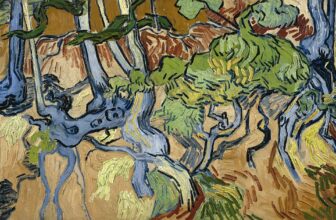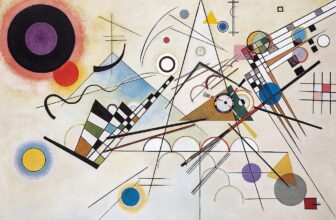
Why Did Piet Mondrian Make Broadway Boogie Woogie?
Piet Mondrian, one of the most influential abstract artists of the 20th century, created Broadway Boogie Woogie in 1942–43 during his time in New York City. This painting marked a significant evolution in his work, reflecting both his personal journey and the cultural energy of the city. But why did Mondrian, known for his strict geometric compositions, turn to the rhythms of New York and jazz music for inspiration?
Mondrian had moved to New York in 1940, fleeing the turmoil of World War II in Europe. He had previously lived in Paris and London, but New York was a revelation. The city’s grid-like layout, its pulsating energy, and, most significantly, the syncopated rhythms of boogie-woogie jazz deeply resonated with him. He saw in the music a parallel to the structured dynamism he sought in his paintings.
Unlike his earlier works, which adhered strictly to the principles of Neoplasticism (his artistic philosophy that emphasized pure abstraction using vertical and horizontal lines, primary colors, and a reduction of form), Broadway Boogie Woogie embraced a newfound sense of movement and vitality. He was captivated by the way the city’s streets and avenues crisscrossed in a rhythmic, almost musical manner. The painting, therefore, was Mondrian’s tribute to the city, its music, and its ceaseless motion.
What Is the Use of Line in Mondrian’s Broadway Boogie Woogie?
In Broadway Boogie Woogie, Mondrian’s use of line takes on an entirely new character compared to his earlier works. While he had previously used long, uninterrupted black lines to divide spaces, in this painting, the lines are fragmented into blocks of color. These lines no longer serve merely as boundaries; instead, they become active elements of the composition, pulsating with an energy reminiscent of the urban environment and jazz music.
The broken lines in Broadway Boogie Woogie mimic the constant movement and rhythm of city life. The squares and rectangles, composed of primary colors, create a visual syncopation much like the beats in boogie-woogie music. The eye is invited to dance across the canvas, much like a pedestrian navigating the bustling streets of Manhattan or a listener following the unpredictable rhythms of jazz.
Mondrian’s earlier compositions often featured a more austere sense of order, with black lines separating blocks of color. However, in Broadway Boogie Woogie, he replaces those black lines with vibrant squares and rectangles, making the structure itself an active participant in the composition. This shift signifies a breakthrough in his artistic evolution, where the city’s energy is not just represented but physically embedded in the painting’s structure.
What Context Is Important to Understand Broadway Boogie Woogie?
To fully appreciate Broadway Boogie Woogie, one must understand the historical, personal, and cultural contexts in which Mondrian created it.
- The Influence of New York City:
- New York City’s grid-like structure provided the perfect inspiration for Mondrian’s geometric abstraction. The intersecting streets and avenues mirrored the compositions he had been developing for years. However, unlike the more rigid and isolated forms in his European works, New York introduced a sense of fluidity and connectivity that transformed his artistic approach.
- The city’s bright neon lights and fast-paced movement infused his work with an unprecedented vibrancy. The painting captures the ceaseless motion of taxis, pedestrians, and the energy of Times Square, translating them into color and rhythm.
- The Role of Jazz and Boogie-Woogie Music:
- Mondrian had a deep appreciation for music, particularly jazz, which he considered the artistic equivalent of his abstract visual style. Boogie-woogie, a popular subgenre of jazz, was especially compelling to him because of its repetitive yet dynamic rhythm.
- The music’s syncopation, improvisation, and layered beats found their visual counterpart in the checkerboard arrangement of Broadway Boogie Woogie. Just as a pianist’s hands move across the keyboard in a lively exchange of beats, the painting’s colors seem to engage in a visual rhythm.
- World War II and Mondrian’s Personal Journey:
- The backdrop of World War II is crucial to understanding the optimism embedded in Broadway Boogie Woogie. Having fled the destruction in Europe, Mondrian found in New York a beacon of hope and resilience. The painting, with its bright colors and rhythmic structure, is a celebration of life, progress, and the potential for new beginnings.
- This was also one of Mondrian’s final works before his death in 1944. It stands as the culmination of his artistic evolution, a final statement that merges his lifelong pursuit of harmony with the dynamic pulse of modern life.
What Museum Is Broadway Boogie Woogie In?
Today, Broadway Boogie Woogie is housed in the Museum of Modern Art (MoMA) in New York City. MoMA, one of the world’s most prestigious modern art institutions, acquired the painting shortly after its completion. It remains one of the highlights of the museum’s collection, drawing visitors who are captivated by its vibrant energy and historical significance.
The painting’s placement in MoMA is fitting, as the museum has been instrumental in promoting and preserving modernist movements, including the De Stijl movement to which Mondrian contributed. At MoMA, Broadway Boogie Woogie is displayed alongside other masterpieces of abstraction, where its rhythmic energy continues to inspire generations of artists and art lovers.
Broadway Boogie Woogie is more than just a painting; it is a celebration of modernity, music, and the transformative power of art. Through his use of fragmented lines, rhythmic color arrangements, and the influence of New York City, Piet Mondrian redefined the possibilities of abstract art. This work stands as a testament to the artist’s ability to translate the world around him into a universal language of form and color.
By understanding the context in which Mondrian created Broadway Boogie Woogie, his escape from war-torn Europe, his fascination with the city’s energy, and his love for jazz music, we gain deeper insight into its significance. The painting is not just a visual representation of New York but an artistic embodiment of its spirit. And housed in MoMA, it continues to pulse with life, much like the city that inspired it.





